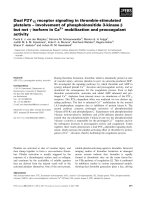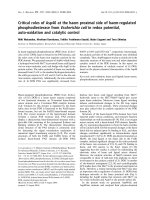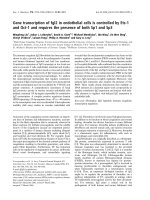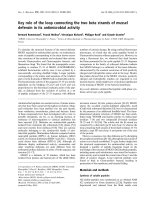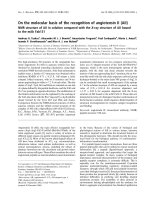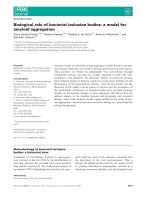Báo cáo khoa học: Dual role of Nbs1 in the ataxia telangiectasia mutateddependent DNA damage response ppt
Bạn đang xem bản rút gọn của tài liệu. Xem và tải ngay bản đầy đủ của tài liệu tại đây (192.86 KB, 7 trang )
MINIREVIEW
Dual role of Nbs1 in the ataxia telangiectasia mutated-
dependent DNA damage response
Joo-Hyeon Lee and Dae-Sik Lim
Department of Biological Sciences, Korea Advanced Institute of Science and Technology, Guseong-D, Yuseong-G, Daejeon, Korea
Eukaryotic cells have evolved a signaling pathway that
is activated by DNA damage. The primary function of
this pathway is to sense DNA strand breaks and then
to amplify the initial signal and convey it to down-
stream effectors that regulate cell cycle checkpoints
and DNA repair [1]. Activation of the DNA damage
signaling pathway by DNA double-strand breaks thus
leads either to arrest of cell cycle progression and
repair of the DNA breaks or, if the damage is too
extensive, to death of the cell by apoptosis, thus ensur-
ing the maintenance of genomic stability. Dysfunction
of this pathway has potentially severe consequences,
such as the development of cancer or other conditions
related to genomic instability [2].
Among many proteins that participate in the DNA
damage signaling pathway, ataxia telangiectasia
mutated (ATM) plays a central role. This serine–thre-
onine kinase is rapidly activated in response to DNA
strand breakage and phosphorylates many targets
important in DNA repair or cell cycle checkpoint acti-
vation [3,4]. The ATM gene was found to be mutated
in individuals with ataxia telangiectasia (AT), a rare
autosomal-recessive disorder with pleiotropic clinical
phenotypes, including progressive neuronal degener-
ation, oculocutaneous telangiectasia, immune dysfunc-
tion, cancer predisposition and premature aging. Cells
derived from affected individuals show defects in
checkpoint control in G1, S and G2 ⁄ M phases of the
Keywords
ATM; cell cycle; checkpoint control; DNA-
damage response; DNA repair; intracellular
signaling; Nbs1; nuclear foci;
phosphorylation
Correspondence
D S. Lim, Department of Biological
Sciences, Biomedical Research Center,
Korea Advanced Institute of Science and
Technology, 373–1 Guseoung-D, Yuseong-G,
Daejeon 305–701, Korea
Fax: +82 42 8692610
Tel: +82 42 8692635
E-mail:
(Received 12 December 2005, accepted
8 February 2006)
doi:10.1111/j.1742-4658.2006.05191.x
The Nbs1 protein associates with Mre11 and Rad50 proteins to form the
Mre11–Rad50–Nbs1 complex, which plays an important role in the
intracellular signaling pathway activated in response to DNA damage.
Mutations in the genes for each of these three components of the Mre11–
Rad50–Nbs1 complex result in human diseases characterized by genomic
instability. Insight into the functions of Nbs1 in the DNA damage response
mediated by the protein kinase, ataxia telangiectasia mutated, has been
provided by recent studies. Nbs1 acts both as a downstream target of
ataxia telangiectasia mutated in the S-phase checkpoint of the cell cycle as
well as an upstream modulator or activator of ataxia telangiectasia
mutated in the DNA damage response.
Abbreviations
AT, ataxia telangiectasia; ATLD, AT-like disorder; ATM, ataxia telangiectasia mutated; BRCT, Brca1 COOH-terminus; Chk2, checkpoint kinase
2; FHA, forkhead associated; IR, ionizing radiation; MRN, Mre11–Rad50–Nbs1; NBS, Nijmegen breakage syndrome; RDS, radioresistant DNA
synthesis.
1630 FEBS Journal 273 (2006) 1630–1636 ª 2006 The Authors Journal compilation ª 2006 FEBS
cell cycle, radiation hypersensitivity and an increased
frequency of chromosome breakage.
A complex of Mre11, Rad50 and Nbs1 proteins (the
so-called MRN complex) is another key player in the
DNA damage signaling pathway [5]. The MRN com-
plex is the primary constituent of nuclear foci that
form rapidly after exposure of cells to ionizing radi-
ation (IR) and which represent sites of ongoing sensing
or repair of DNA double-strand breaks. Hypomorphic
mutations of the Nbs1 gene in humans give rise to
Nijmegen breakage syndrome (NBS), which is charac-
terized by microcephaly, immunodeficiency, chromoso-
mal instability, predisposition to cancer and cells that
show hypersensitivity to IR and abnormal S-phase
checkpoint control [6,7]. Germline hypomorphic muta-
tions of the Mre11 gene also result in an AT-like dis-
order (ATLD) [8]. The phenotypic similarities among
AT, NBS and ATLD indicate that the MRN complex
functions in the ATM-dependent signaling pathway
activated by DNA damage [9]. In this review, we will
discuss recent advances in our understanding of Nbs1
function in the ATM-dependent DNA damage signa-
ling pathway.
Functional domains of Nbs1 relevant to
the DNA damage signaling pathway
The human Nbs1 gene was originally cloned by two
independent groups with the use of a positional clo-
ning approach and direct amino acid sequencing of a
95-kDa protein (p95) that was found to associate with
human Mre11 [6,7]. The 754-amino acid protein, p95,
encoded by the Nbs1 gene shows a low level of
sequence similarity to Saccharomyces cerevisiae Xrs2p.
Nbs1 contains a forkhead-associated (FHA) domain
and a Brca1 COOH-terminus (BRCT) domain in its
NH
2
-terminal region, as well as an Mre11-binding
domain and an ATM-binding domain in its COOH-
terminal region (Fig. 1). FHA and BRCT domains are
often present in eukaryotic nuclear proteins involved
in cell cycle checkpoint control or DNA repair. The
FHA domain appears to interact with target proteins
in a phosphorylation-dependent manner, and the
BRCT domain also mediates protein–protein interac-
tions.
The functional significance of the FHA and BRCT
domains in Nbs1 has been indicated by several studies.
Cells derived from individuals with NBS that express
an Nbs1 protein with a mutation in either of these
domains manifest both a defect in IR-induced forma-
tion of MRN foci and hypersensitivity to IR [10,11].
Another study found that neither domain contributed
to radiation resistance [12], whereas yet another
showed that both FHA and BRCT domains were
required for S-phase checkpoint control, but that only
the BRCT domain was essential for radiation resist-
ance [13]. These discrepancies are probably caused by
differences in the doses of radiation, in Nbs1 muta-
tions, or in Nbs1 expression levels among the studies.
The FHA and BRCT domains participate in the
interaction of Nbs1 with the phosphorylated histone,
c-H2AX, which occurs near sites of DNA strand
breakage [14]. Mouse cells that lack c-H2AX do not
form Nbs1 foci after exposure to IR, suggesting that
the direct interaction of Nbs1 with c-H2AX is required
for foci formation by the MRN complex [15]. Cell
cycle checkpoint control appears largely intact in the
c-H2AX-deficient cells, however, suggesting that foci
formation is not directly related to checkpoint func-
tion. The MRN-interacting protein, MDC1, was
recently shown to contribute to the formation of foci
containing Nbs1, 53BP1 and Brca1, on the basis of the
observation that down-regulation of MDC1 prevented
the formation of such foci in response to IR [15–18].
Whether or not the FHA or BRCT domains of Nbs1
directly interacts with MDC1 remains unclear.
Although the functional relevance of the FHA and
BRCT domains of Nbs1 appears to differ among stud-
ies, we can conclude that both domains are required
for recruitment of the MRN complex to DNA lesions
(possibly through interaction with c-H2AX or MDC1)
and consequent foci formation, as well as for cell sur-
vival after exposure to IR.
Two serine residues at positions 278 and 343 of
human Nbs1 are phosphorylated by ATM on exposure
of cells to IR. Cells expressing Nbs1 proteins with
mutations at these phosphorylation sites exhibit defect-
ive S-phase checkpoint control, suggesting that Nbs1
phosphorylation by ATM is required at least for acti-
vation of the S-phase checkpoint in response to IR
FHA
BRCT
Mre11-binding
Serine 278
Serine 343
Foci formation
Radiation resistance
-H2AX binding
S phase checkpoint?
S phase checkpoint
Radiation resistance?
MRN complex
formation
Radiation resistance
Cell cycle checkpoint
ATM-binding
Recruitment of ATM
to IR-induced foci
754
0
Fig. 1. Functional domains of Nbs1. The forkhead-associated (FHA)
and Brca1 COOH-terminus (BRCT) domains in the NH
2
-terminal
region bind to c-H2AX and are required for ionizing radiation (IR)-
induced foci formation and radiation resistance. Phosphorylation
of Ser278 and Ser343 by ataxia telangiectasia mutated (ATM) is
essential for activation of the S-phase checkpoint. The Mre11-bind-
ing domain is responsible for binding to Mre11 during formation of
the Mre11–Rad50–Nbs1 (MRN) complex. The ATM-binding domain
at the COOH-terminus binds to ATM and mediates recruitment of
ATM to IR-induced foci.
J H. Lee and D S. Lim Role of Nbs1 in ATM-dependent DNA damage signaling
FEBS Journal 273 (2006) 1630–1636 ª 2006 The Authors Journal compilation ª 2006 FEBS 1631
[19–21]. This finding might explain, in part, the failure
of cells from patients with AT or NBS to arrest DNA
synthesis in response to IR (radioresistant DNA syn-
thesis, RDS). However, it remains controversial
whether Nbs1 phosphorylation is also required for
radiation resistance or IR-induced formation of MRN
foci [19–21].
The Mre11-binding domain of human Nbs1 has
been localized to amino acids 682–693 in the COOH-
terminal region of the protein. Deletion of this region
of Nbs1 results in a cellular phenotype virtually identi-
cal to that of NBS, including defective formation of
MRN foci, radiation hypersensitivity and the impair-
ment of checkpoint control [10,22]. These observations
suggest that the association of Nbs1 with Mre11–
Rad50 is essential for its role in the DNA damage
response. In addition, the extreme COOH-terminal
region (amino acids 734–754) of Nbs1 mediates the
interaction of Nbs1 with ATM and the recruitment of
ATM to sites of DNA damage, thereby promoting
ATM-dependent signaling [23]. Domains similar to
the ATM-binding domain of Nbs1 are also found in
ATRIP and Ku80 and are required for the interaction
of these proteins with the ATM-related kinase, ATR,
and the catalytic subunit of DNA-dependent protein
kinase (DNA-PKcs), respectively. This conserved motif
found in Nbs1, ATRIP and Ku80 thus appears to be
important for DNA damage responses mediated by
ATM, ATR and DNA-PKcs.
Role of Nbs1 in DNA damage
checkpoint control
The similar clinical phenotypes of AT, NBS and
ATLD suggested that the MRN complex functions in
the same DNA damage response pathway as does
ATM. Cells from individuals with NBS exhibit partial
defects in cell cycle checkpoint control after irradi-
ation. Both NBS and ATLD cells fail to transiently
inhibit DNA replication in the presence of DNA
strand breaks; they thus show the RDS phenotype.
This phenotype reflects a failure of intra S-phase
checkpoint control and was first characterized in AT
cells [24]. This shared RDS phenotype was explained
at the molecular level by the observations that ATM
phosphorylates Nbs1 on Ser278 and Ser343 and that
expression of an Nbs1 protein in which Ser343 is
replaced by alanine failed to rescue the S-phase check-
point defect in NBS cells. Phosphorylation of the pro-
tein SMC1 on Ser957 and Ser966 by ATM, which is
necessary for activation of the S-phase checkpoint
[25,26], also requires Nbs1 and Brca1. These findings
indicate that SMC1 regulation by both ATM and
Nbs1 is essential for S-phase checkpoint control. The
observation that the RDS phenotype of NBS cells is
less pronounced than that of AT cells suggested that
the S-phase checkpoint might also be regulated in an
Nbs1-independent manner [27]. Indeed, the kinase,
checkpoint kinase 2 (Chk2) was shown to be a target
of ATM in S-phase checkpoint control, indicating that
ATM regulates two parallel pathways to achieve such
control. However, phosphorylation of Chk2 by ATM
also requires Nbs1 in cells subjected to low-dose irradi-
ation (1–2 Gy); it does not require Nbs1 in those
exposed to high-dose radiation (> 4 Gy) [10,28].
Together, these various observations suggest that sign-
aling by ATM and Nbs1 may differentially influence
SMC1 or Chk2 in S-phase checkpoint control, depend-
ing on the extent of DNA damage.
The contribution of Nbs1 to the G1 and G2 ⁄ M
checkpoints remains controversial. NBS cells have
been found to be defective in the induction of p53 and
in G1 checkpoint control in some studies, but not in
others [19,29–32]. A partial defect in G1 checkpoint
control, and in the induction of p53 and p21, was
apparent in NBS cells exposed to low-dose radiation,
but not in those subjected to high-dose irradiation. In
addition, the activation of Chk2 in the G2 ⁄ M check-
point was found to be impaired in NBS cells after low-
dose irradiation [28], but G2 ⁄ M checkpoint control in
NBS cells was found to be normal in other studies
[10,28,33]. Similar discrepancies have arisen in studies
of mice with mutations in the Nbs1 gene [9]. Most
human NBS cells express an NH
2
-terminally truncated
Nbs1 protein that contains an intact Mre11-binding
domain. Differences in the nature of the Nbs1 muta-
tion, as well as in the dose of radiation administered
to NBS cells, thus probably underlie, at least in part,
the discrepancies among studies with regard to the
contribution of Nbs1 to the G1 or G2 ⁄ M checkpoints.
Dual role of Nbs1 in ATM-dependent
DNA damage signaling
The rapid localization of the MRN complex to the
region of DNA strand breaks, and consequent forma-
tion of MRN foci in cells exposed to IR, led to the
hypothesis that the MRN complex functions in the
sensing of DNA strand breakage and in the activation
of the ATM-dependent DNA damage signaling path-
way [6,34–36]. However, normal activation of the kin-
ase activity of ATM and phosphorylation of the ATM
target site (Ser15) in p53 were observed in NBS cells
exposed to high-dose radiation [19]. Moreover, the
observation that Nbs1 phosphorylation by ATM is
required for intra S-phase checkpoint control [19–21]
Role of Nbs1 in ATM-dependent DNA damage signaling J H. Lee and D S. Lim
1632 FEBS Journal 273 (2006) 1630–1636 ª 2006 The Authors Journal compilation ª 2006 FEBS
indicated that Nbs1 functions downstream (not up-
stream) of ATM in the DNA damage signaling path-
way. Nevertheless, several studies showed that ATM
activation in response to low-dose irradiation was par-
tially defective in NBS and ATLD cells [11,37,38].
Regulation of ATM targets, such as Chk2 and SMC1,
has consistently been found to be largely dependent on
the MRN complex, even though Nbs1 is not abso-
lutely required for Chk2 or SMC1 phosphorylation
by ATM in cells exposed to high doses of IR
[10,11,25,28,39]. Together, the available data suggest
that Nbs1 functions as a downstream target of ATM,
as well as a modulator of ATM activity, facilitating
ATM activation and ATM-dependent phosphorylation
of many downstream substrates in the ATM-depend-
ent DNA damage signaling pathway [10,11,39].
Given that ATM is a central player in the cellular
response to DNA strand breakage, it is important to
understand the mechanisms both by which it is activa-
ted and by which it signals to downstream effectors in
cells with DNA strand breaks. To date, more studies
have focused on the identification of downstream tar-
gets of ATM [3] than on the molecular mechanism of
ATM activation. Important insight into the mechanism
of ATM activation has been provided by a recent
study [40] showing that ATM exists as a catalytically
inactive dimer or higher-order multimer in the absence
of DNA damage. In response to DNA damage, how-
ever, ATM undergoes rapid autophosphorylation on
Ser1981, resulting in dissociation of the inactive
homodimers or multimers to yield active monomers.
This autophosphorylation of ATM is triggered in cells
within minutes after low-dose irradiation, or even in
the presence of two exogenous DNA strand breaks per
cell [40]. In addition to DNA damage, chromatin
structure-changing molecules are able to induce rapid
activation of ATM in the absence of detectable DNA
strand breakage [40]. The activation of ATM by DNA
strand breakage might thus be mediated, at least in
part, by a consequent change in chromatin structure.
Further insight into the mechanism of ATM activa-
tion has been provided by several recent studies
[23,41,42] showing that the MRN complex plays a role
both in the recruitment of ATM to the region of DNA
strand breakage and in thr activation of ATM in a
manner dependent on DNA strand breaks. Whether
ATM directly recognizes or senses DNA strand
breaks, or whether it is activated directly by such
strand breaks, is unclear. Neither ATM immunopre-
cipitated from cells, nor purified ATM, was found to
be directly activated by DNA stand ends in some stud-
ies, whereas purified ATM was shown to bind to DNA
ends and its activity to be enhanced by them in others
[3]. These contradictory results, with regard to the
importance of DNA strand breaks in ATM activation
in vitro, suggested the possibility that the status of
ATM or cofactors might determine the effect of DNA
strand ends on ATM activity. The situation has been
clarified by the recent biochemical evidence provided
by two studies showing that the MRN complex is
important for the activation of ATM [41,42]. The puri-
fied recombinant MRN complex was thus found to
increase the ability of ATM purified from cells (prob-
ably a mixture of monomers and dimers or multimers)
to phosphorylate target substrates in the absence of
DNA strand breaks [41]. Under these conditions, an
MRN complex containing an Nbs1 protein in which
Ser343 is replaced with alanine failed to stimulate
ATM activity, suggesting that both the presence of
Nbs1 and its phosphorylation by ATM are required
for stimulation of ATM activity by the MRN complex.
In contrast to the lack of a requirement of DNA
strand breaks for ATM activation in this latter study,
highly purified inactive ATM dimers or multimers were
found, in the second study, to be activated by the
MRN complex only in the presence of DNA strand
ends, resulting in the phosphorylation of downstream
targets [42]. Furthermore, both Nbs1 and the unwind-
ing of DNA ends by Mre11–Rad50 were found to be
sufficient for stimulating ATM activity in vitro. The
presence of both the MRN complex and DNA strand
breaks thus appeared to result in the efficient convers-
ion of inactive ATM dimers or multimers to active
monomers. Consistent with this result, the extreme
COOH-terminal region of Nbs1 is responsible for
association with ATM and the recruitment of ATM to
sites of DNA strand breakage [23].
Surprisingly, mutation of the autophosphorylation
site of ATM (Ser1981 to alanine) affected neither the
dimer-to-monomer transition of ATM nor the stimula-
tion of its kinase activity induced by the MRN com-
plex in the presence of DNA strand breaks in vitro
[42], suggesting that autophosphorylation of ATM on
Ser1981 is not required for ATM activation induced
by the MRN complex and DNA breaks. This conclu-
sion is inconsistent with the previous in vivo finding
that autophosphorylation of ATM on Ser1981 is an
indicator of ATM activation and monomeric status in
cells exposed to radiation [40]. The reason for this con-
tradiction remains unknown. It is possible that, in the
presence of DNA strand breaks, the MRN complex
preferentially binds inactive dimers or multimers of
ATM and induces their dissociation to yield partially
active monomers that have an increased tendency to
undergo autophosphorylation on Ser1981 and thereby
generate the fully activated kinase. Autophosphoryla-
J H. Lee and D S. Lim Role of Nbs1 in ATM-dependent DNA damage signaling
FEBS Journal 273 (2006) 1630–1636 ª 2006 The Authors Journal compilation ª 2006 FEBS 1633
tion of ATM on Ser1981 may stabilize the active
monomer or prevent its oligomerization. Indeed, an
ATM protein in which Ser1981 is replaced by aspartic
acid, which mimics the autophosphorylated form of
the kinase, appears to exist as a monomer [42],
although the activity of this mutant was not evaluated.
Alternatively, phosphorylation of ATM at other sites,
even in the absence of phosphorylation on Ser1981,
may be sufficient for the dimer-to-monomer transition
triggered by the MRN complex and DNA strand
breaks, at least in vitro. Elucidation of the structure of
the ATM–MRN complex should provide further
insight into the molecular mechanism of ATM activa-
tion by MRN and DNA strand breaks.
Conclusion
Although the role of Nbs1 in the ATM-dependent
signaling pathway remains controversial, it is now gen-
erally accepted that Nbs1 plays a dual role both as a
downstream target and an upstream regulator of ATM
(Fig. 2). The role of Nbs1, as an upstream regulator of
ATM, appears both to depend on the dose of radi-
ation to which cells are exposed as well as to be differ-
entially affected by Nbs1 gene mutations. Cells from
NBS or ATLD patients, with hypomorphic mutations
in the corresponding genes, still manifest partial ATM
activity as a result of the expression of truncated Nbs1
or Mre11, respectively; such cells thus exhibit only par-
tial checkpoint defects after exposure to low doses of
radiation. In cells subjected to low-dose irradiation,
Nbs1 is required for both activation of ATM and its
recruitment to sites of DNA damage. In contrast,
Nbs1 is no longer necessary for ATM activation and
subsequent checkpoint control (with the exception of
the intra S-phase checkpoint) in cells exposed to high
doses of radiation. High doses of IR may generate
more DNA strand breaks and abnormal chromatin
structures that exceed a threshold for the activation of
ATM in the absence of Nbs1.
Acknowledgements
D S.L. was supported by the National Research
Laboratory Program and the 21st Century Frontier
Functional Human Genome Project of Korea.
References
1 Zhou BB & Elledge SJ (2000) The DNA damage
response: putting checkpoints in perspective. Nature
408, 433–439.
2 Elledge SJ (1996) Cell cycle checkpoints: preventing an
identity crisis. Science 274, 1664–1672.
3 Kastan MB & Lim DS (2000) The many substrates and
functions of ATM. Nat Rev Mol Cell Biol 1, 179–186.
4 Shiloh Y & Kastan MB (2001) ATM: genome stability,
neuronal development, and cancer cross paths. Adv
Cancer Res 83, 209–254.
5 Petrini JH (1999) The mammalian Mre11-Rad50-Nbs1
protein complex: integration of functions in the cellular
DNA-damage response. Am J Hum Genet 64, 1264–
1269.
6 Carney JP, Maser RS, Olivares H, Davis EM, Le Beau
M, Yates JR, 3rd, Hays L, Morgan WF & Petrini JH
(1998) The hMre11 ⁄ hRad50 protein complex and
Checkpoint activation
DNA repair at foci
ATM dimer (inactive)
ATM monomer (active)
MRN (Mre11-Rad50-Nbs1)
ATM target (p53)
ATM targets (SMC1, Brca1, etc)
DNA breaks
Chromatin changesChromatin
Fig. 2. Model for the dual role of Nbs1 in
the ataxia telangiectasia mutated (ATM)-
dependent DNA damage signaling pathway.
The DNA strand breaks and altered chroma-
tin structure induced by ionizing radiation
(IR) result in the recruitment, by the Mre11–
Rad50–Nbs1 (MRN) complex, of ATM to the
sites of DNA strand breakage. This recruit-
ment also induces the conversion of inactive
ATM dimers to partially active monomers.
Autophosphorylation of ATM is also directly
induced by changes in chromatin structure,
resulting in full activation of ATM mono-
mers. The activated monomeric ATM then
phosphorylates its many downstream tar-
gets, including p53, Nbs1, SMC1 and Brca1,
to mediate checkpoint controls and elicit
repair of the damaged DNA.
Role of Nbs1 in ATM-dependent DNA damage signaling J H. Lee and D S. Lim
1634 FEBS Journal 273 (2006) 1630–1636 ª 2006 The Authors Journal compilation ª 2006 FEBS
Nijmegen breakage syndrome: linkage of double-strand
break repair to the cellular DNA damage response. Cell
93, 477–486.
7 Varon R, Vissinga C, Platzer M, Cerosaletti KM,
Chrzanowska KH, Saar K, Beckmann G, Seemanova E,
Cooper PR, Nowak NJ et al. (1998) Nibrin, a novel
DNA double-strand break repair protein, is mutated in
Nijmegen breakage syndrome. Cell 93, 467–476.
8 Stewart GS, Maser RS, Stankovic T, Bressan DA,
Kaplan MI, Jaspers NG, Raams A, Byrd PJ, Petrini JH
& Taylor AM (1999) The DNA double-strand break
repair gene hMRE11 is mutated in individuals with an
ataxia-telangiectasia-like disorder. Cell 99, 577–587.
9 Stracker TH, Theunissen JW, Morales M & Petrini JH
(2004) The Mre11 complex and the metabolism of chro-
mosome breaks: the importance of communicating and
holding things together. DNA Repair (Amst) 3, 845–
854.
10 Lee JH, Xu B, Lee CH, Ahn JY, Song MS, Lee H,
Canman CE, Lee JS, Kastan MB & Lim DS (2003)
Distinct functions of Nijmegen breakage syndrome in
ataxia telangiectasia mutated-dependent responses to
DNA damage. Mol Cancer Res 1, 674–681.
11 Horejsi Z, Falck J, Bakkenist CJ, Kastan MB, Lukas J
& Bartek J (2004) Distinct functional domains of Nbs1
modulate the timing and magnitude of ATM activation
after low doses of ionizing radiation. Oncogene 23,
3122–3127.
12 Tauchi H, Kobayashi J, Morishima K, Matsuura S,
Nakamura A, Shiraishi T, Ito E, Masnada D, Delia D
& Komatsu K (2001) The forkhead-associated domain
of NBS1 is essential for nuclear foci formation after
irradiation but not essential for hRAD50ÆhMRE11ÆNBS1
complex DNA repair activity. J Biol Chem 276, 12–15.
13 Zhao S, Renthal W & Lee EY (2002) Functional analy-
sis of FHA and BRCT domains of NBS1 in chromatin
association and DNA damage responses. Nucleic Acids
Res 30, 4815–4822.
14 Kobayashi J, Tauchi H, Sakamoto S, Nakamura A,
Morishima K, Matsuura S, Kobayashi T, Tamai K,
Tanimoto K & Komatsu K (2002) NBS1 localizes to
c-H2AX foci through interaction with the FHA ⁄ BRCT
domain. Curr Biol 12, 1846–1851.
15 Celeste A, Petersen S, Romanienko PJ, Fernandez-
Capetillo O, Chen HT, Sedelnikova OA, Reina-San-
Martin B, Coppola V, Meffre E, Difilippantonio MJ
et al. (2002) Genomic instability in mice lacking histone
H2AX. Science 296, 922–927.
16 Goldberg M, Stucki M, Falck J, D’Amours D, Rahman
D, Pappin D, Bartek J & Jackson SP (2003) MDC1 is
required for the intra-S-phase DNA damage checkpoint.
Nature 421, 952–956.
17 Lou Z, Minter-Dykhouse K, Wu X & Chen J (2003)
MDC1 is coupled to activated CHK2 in mammalian
DNA damage response pathways. Nature 421, 957–961.
18 Stewart GS, Wang B, Bignell CR, Taylor AM &
Elledge SJ (2003) MDC1 is a mediator of the mamma-
lian DNA damage checkpoint. Nature 421, 961–966.
19 Lim DS, Kim ST, Xu B, Maser RS, Lin J, Petrini JH &
Kastan MB (2000) ATM phosphorylates p95 ⁄ Nbs1 in
an S-phase checkpoint pathway. Nature 404, 613–617.
20 Wu X, Ranganathan V, Weisman DS, Heine WF, Cic-
cone DN, O’Neill TB, Crick KE, Pierce KA, Lane WS,
Rathbun G et al. (2000) ATM phosphorylation of Nij-
megen breakage syndrome protein is required in a DNA
damage response. Nature 405, 477–482.
21 Zhao S, Weng YC, Yuan SS, Lin YT, Hsu HC, Lin SC,
Gerbino E, Song MH, Zdzienicka MZ, Gatti RA et al.
(2000) Functional link between ataxia-telangiectasia and
Nijmegen breakage syndrome gene products. Nature
405, 473–477.
22 Desai-Mehta A, Cerosaletti KM & Concannon P (2001)
Distinct functional domains of nibrin mediate Mre11
binding, focus formation, and nuclear localization. Mol
Cell Biol 21, 2184–2191.
23 Falck J, Coates J & Jackson SP (2005) Conserved
modes of recruitment of ATM, ATR and DNA-PKcs to
sites of DNA damage. Nature 434, 605–611.
24 Shiloh Y (1997) Ataxia-telangiectasia and the Nijmegen
breakage syndrome: related disorders but genes apart.
Annu Rev Genet 31, 635–662.
25 Kim ST, Xu B & Kastan MB (2002) Involvement of the
cohesin protein, Smc1, in Atm-dependent and indepen-
dent responses to DNA damage. Genes Dev 16, 560–
570.
26 Yazdi PT, Wang Y, Zhao S, Patel N, Lee EY & Qin J
(2002) SMC1 is a downstream effector in the
ATM ⁄ NBS1 branch of the human S-phase checkpoint.
Genes Dev 16, 571–582.
27 Falck J, Petrini JH, Williams BR, Lukas J & Bartek J
(2002) The DNA damage-dependent intra-S phase
checkpoint is regulated by parallel pathways. Nat Genet
30, 290–294.
28 Buscemi G, Savio C, Zannini L, Micciche F, Masnada
D, Nakanishi M, Tauchi H, Komatsu K, Mizutani S,
Khanna K et al. (2001) Chk2 activation dependence
on Nbs1 after DNA damage. Mol Cell Biol 21, 5214–
5222.
29 Jongmans W, Vuillaume M, Chrzanowska K, Smeets
D, Sperling K & Hall J (1997) Nijmegen breakage syn-
drome cells fail to induce the p53-mediated DNA
damage response following exposure to ionizing radia-
tion. Mol Cell Biol 17, 5016–5022.
30 Yamazaki V, Wegner RD & Kirchgessner CU (1998)
Characterization of cell cycle checkpoint responses after
ionizing radiation in Nijmegen breakage syndrome cells.
Cancer Res 58, 2316–2322.
31 Matsuura K, Balmukhanov T, Tauchi H, Weemaes C,
Smeets D, Chrzanowska K, Endou S, Matsuura S &
Komatsu K (1998) Radiation induction of p53 in cells
J H. Lee and D S. Lim Role of Nbs1 in ATM-dependent DNA damage signaling
FEBS Journal 273 (2006) 1630–1636 ª 2006 The Authors Journal compilation ª 2006 FEBS 1635
from Nijmegen breakage syndrome is defective but not
similar to ataxia-telangiectasia. Biochem Biophys Res
Commun 242, 602–607.
32 Girard PM, Riballo E, Begg AC, Waugh A & Jeggo PA
(2002) Nbs1 promotes ATM dependent phosphorylation
events including those required for G1 ⁄ S arrest. Onco-
gene 21, 4191–4199.
33 Xu B, Kim ST, Lim DS & Kastan MB (2002) Two
molecularly distinct G
2
⁄ M checkpoints are induced by
ionizing irradiation. Mol Cell Biol 22, 1049–1059.
34 Maser RS, Monsen KJ, Nelms BE & Petrini JH (1997)
hMre11 and hRad50 nuclear foci are induced during the
normal cellular response to DNA double-strand breaks.
Mol Cell Biol 17, 6087–6096.
35 Nelms BE, Maser RS, MacKay JF, Lagally MG &
Petrini JH (1998) In situ visualization of DNA double-
strand break repair in human fibroblasts. Science 280,
590–592.
36 Mirzoeva OK & Petrini JH (2001) DNA damage-depen-
dent nuclear dynamics of the Mre11 complex. Mol Cell
Biol 21, 281–288.
37 Carson CT, Schwartz RA, Stracker TH, Lilley CE, Lee
DV & Weitzman MD (2003) The Mre11 complex is
required for ATM activation and the G2 ⁄ M checkpoint.
EMBO J 22, 6610–6620.
38 Uziel T, Lerenthal Y, Moyal L, Andegeko Y, Mittel-
man L & Shiloh Y (2003) Requirement of the MRN
complex for ATM activation by DNA damage. EMBO
J 22, 5612–5621.
39 Kitagawa R, Bakkenist CJ, McKinnon PJ & Kastan
MB (2004) Phosphorylation of SMC1 is a critical down-
stream event in the ATM-NBS1-BRCA1 pathway.
Genes Dev 18, 1423–1438.
40 Bakkenist CJ & Kastan MB (2003) DNA damage acti-
vates ATM through intermolecular autophosphorylation
and dimer dissociation. Nature 421, 499–506.
41 Lee JH & Paull TT (2004) Direct activation of the
ATM protein kinase by the Mre11 ⁄ Rad50 ⁄ Nbs1 com-
plex. Science 304, 93–96.
42 Lee JH & Paull TT (2005) ATM activation by DNA
double-strand breaks through the Mre11-Rad50-Nbs1
complex. Science 308, 551–554.
Role of Nbs1 in ATM-dependent DNA damage signaling J H. Lee and D S. Lim
1636 FEBS Journal 273 (2006) 1630–1636 ª 2006 The Authors Journal compilation ª 2006 FEBS

